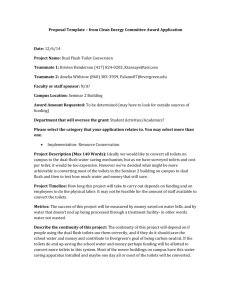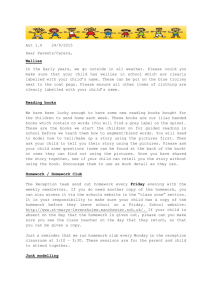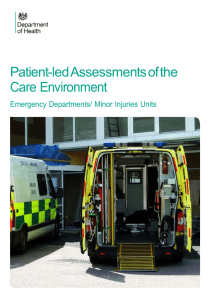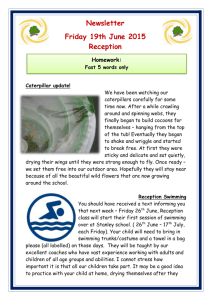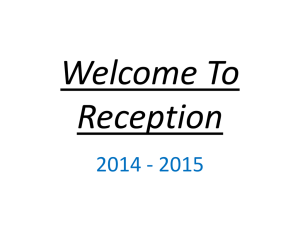Communal Areas - Health & Social Care Information Centre
advertisement
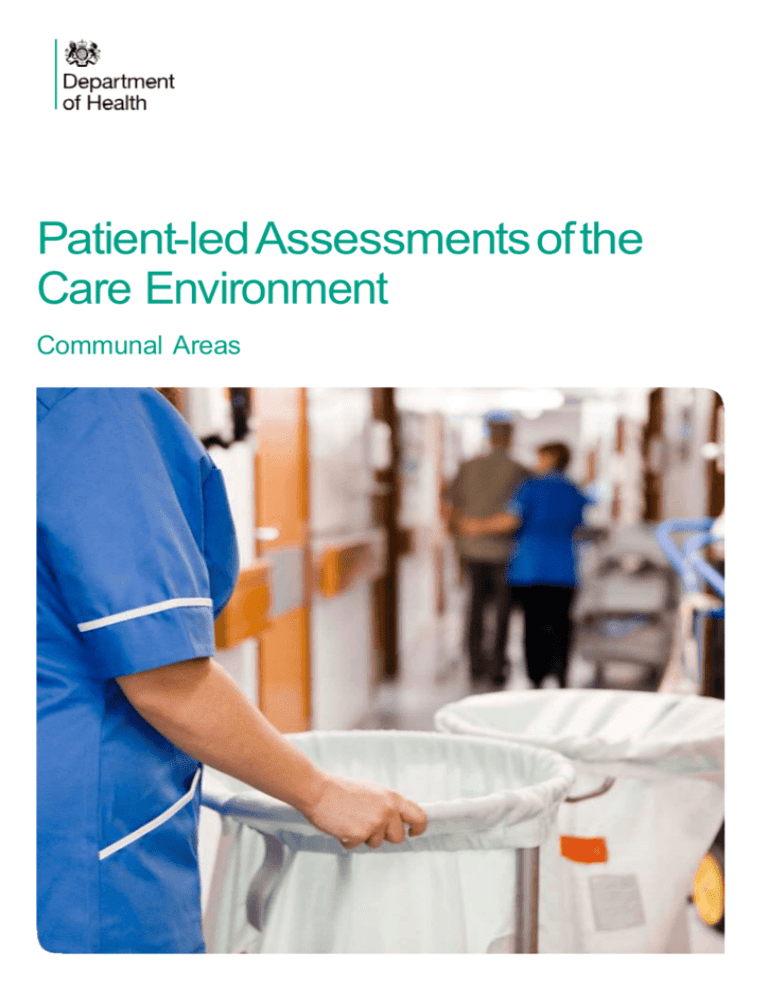
Patient-led Assessments of the Care Environment Communal Areas You may re-use the text of this document (not including logos) free of charge in any format or medium, under the terms of the Open Government Licence. To view this licence, visit www.nationalarchives.gov.uk/ doc/open-government-licence/ © Crown copyright Published to gov.uk, in PDF format only. www.gov.uk/dh Communal areas (entrances, corridors and lifts, public toilets, bereavement rooms) COMMUNAL AREAS CLEANLINESS Pass = P Qualified Pass = Q Fail = F Not Applicable = X Please see page 9 of this assessment form for definitions of Clean, Pass, Qualified Pass and Fail Other e.g. bereavement or therapy rooms, Public toilets Corridors, lifts, stairwells Main reception LEAVE SHADED AREAS BLANK Notes optional (reasons for failure must be recorded) Ceilings Curtains/blinds Dispensers – soap/hand gel etc Doors and frames Floor Glazing – internal Lighting Mirrors Pull cords/switches Radiators, heating panels and pipework Seating Sinks/basins Surfaces – high Surfaces – low/visible (incl fire extinguishers) Toilet TV/entertainment equipment Ventilation/air-conditioning grilles (visible) Waste bins Wheelchairs/walking aids The assessment – Communal Areas 3 CONDITION/APPEARANCE – 1 of 5 Pass = P Qualified Pass = Q Fail = F Not Applicable = X Internal decoration Reception Corridors, lifts, stairwells Public toilets Should be bright, co-ordinated and in good condition. Paintwork should be free from chips, scratches and other damage. Wallpaper (if any) should be free from damage – tears etc, and should be appropriate to the patients – e.g. on children’s wards it should not only suit the very young. Artwork should be clean and in good condition. Other Notes optional (reasons for failure must be recorded) Internal fixtures and fittings (excluding floors, furnishings and decorations) Reception Corridors, lifts, stairwells Public toilets Other These should be free from permanent damage and marks (i.e. that cannot be removed by cleaning), and working. There should be clear instructions displayed on how to report broken/malfunctioning items. The list below covers the majority of issues, but others should be recorded as and when they are seen. • Free from stains/marks (including water damage and permanent marks caused by adhesive residues) • Free from scuffs, scratches, gouges, tears, holes (including exposed screw-holes), corrosion/rust, limescale or other deposits • Any items which have an action – e.g. automatic doors, taps, lights – should be working correctly • Toilets and bathrooms must have working locks (except in ensuite rooms where the outer door can be locked) • Ceiling tiles – unless there is current maintenance work that requires ceiling tiles to be removed, all should be in place and in good condition • Hand-washing water should not be too hot. Notes optional (reasons for failure must be recorded) 4 The assessment – Communal Areas CONDITION/APPEARANCE – 2 of 5 Floors Reception Corridors, lifts, stairwells All floors should be even, free from tears, splits, excessive wear, cracks, tape or raised/lifting areas. Any carpeting should be appropriate to the area. Barrier matting in e.g. entrances should be in good condition and firmly fixed in place. Public toilets Other Notes optional (reasons for failure must be recorded) Seating Reception Corridors, lifts, stairwells Other Chairs and seating should be made from wipeable/ impervious material. Also: • It should be in good condition (e.g. free from permanent stains/ marks, excessive wear, fraying or tears or, in the case of plastic seating, not cracked or broken) • Where seating is fixed to the floor, fixings should be robust and in good repair so that seating is not loose • There should be small seating areas for people to rest along the corridors Notes optional (reasons for failure must be recorded) Lighting/natural light Reception Corridors, lifts, stairwells Other Natural light should be available wherever possible, particularly on wards. Where artificial lighting is used, this should simulate natural light and provide enough light to make areas bright and easy to walk through. Lighting should also be even e.g. without pools of light and/or dark areas, stripes or shadows. Energy-saving/motionactivated lighting is acceptable, but should be designed to respond quickly and to light the area well, particularly in long corridors, lifts or areas where there is no natural light. Bulbs etc should be working. Notes optional (reasons for failure must be recorded) The assessment – Communal Areas 5 CONDITION/APPEARANCE – 3 of 5 Odours Reception Corridors, lifts, stairwells Areas should smell fresh and should be well ventilated to ensure there are no lingering unpleasant odours. Smells caused by cleaning products are often reassuring for patients, but should not be so strong that they are offensive. Public toilets Other Notes optional (reasons for failure must be recorded) General storage Corridors, lifts, stairwells Public toilets Other Tidiness is important since not only does a tidy ward or area create an impression of order and good management, but also an untidy ward/area significantly impacts on the ability to clean. The following are key aspects of providing a tidy environment: • Equipment, when not in use, should be stored out of sight in rooms or areas set aside for that purpose • Bathrooms, toilets or other patient areas, e.g. day rooms, should never be used for storage • Boxes should not be stored on the floor or cupboard tops or other level surfaces, since this presents a potential hazard • Nothing should ever be stored in doorways Notes optional (reasons for failure must be recorded) General tidiness Reception Corridors, lifts, stairwells Other • Reception areas should look neat and tidy • Noticeboards should display only essential information and upto-date notices • There should be separate noticeboards for patient and staff information • Temporary signs should be up to date, relevant and of good quality (e.g. printed and laminated). Notes optional (reasons for failure must be recorded) 6 The assessment – Communal Areas CONDITION/APPEARANCE – 4 of 5 Waste Management Reception Corridors, lifts, stairwells Public toilets Other There should be enough waste bins to help keep litter to a minimum. Also: • They should have liners, be big enough for the area/ purpose, and be emptied regularly and not overflow • They should have ‘no touch’ or foot-operated mechanisms, which should be working • They should have a solid outer cover (i.e. no ‘free-hanging’ bags) • Clinical waste storage bins should always be locked and should never be so full that they prevent closing. Notes optional (reasons for failure must be recorded) ACCESS Are there handrails in corridors? (N/A applies only where there are no corridors). Note: Particular attention should be paid to handrails on the approaches to toilets. Y/N/ NA Is it possible to grasp the handrails properly Y/N Are the handrails in a colour that contrasts with the walls? Y/N Are there small seating areas for people to rest along corridors? Note: Assessing teams will need to determine for themselves whether the corridor is of sufficient length to warrant seating, but should err on the side of caution given some patients will be able to walk only very short distances without needing to rest. N/A may be used where it is determined no seating is necessary Y/N/ NA RECEPTION/WAITING AREAS Where there are steps to the reception area, is there a ramp to assist those with mobility difficulties? Y/N/ NA Where there is a ramp, does it have a slip-resistant surface which still allows a ‘shuffling’ gait? Y/N Does seating provided in reception/ waiting areas provide for the range of patient needs including chairs of different heights, chairs both with and without arms and bariatric chairs? (N/A only to be used where there is no reception/waiting area) Y/N/ NA Is there space in reception areas for wheelchairs and for those accompanying patients to sit together? Y/N Is there a hearing loop or other portable assistive system at the reception desk? N/A only where there is no reception desk Y/N/ NA The assessment – Communal Areas 7 Is there at least one generally available toilet big enough to allow space for a wheelchair and carer (including staff) to assist when the door is closed? N/A only where there are no toilets in Common Areas Y/N/ NA LIFTS Are there lifts for patient/visitor use in the building? Note: If No, ignore the rest of this section Y/N Are lifts well signposted and easy to find? Y/N Do all lifts have large control buttons? Y/N Do all control buttons include braille? Y/N Do lifts have audible announcements for notifying floor levels? Y/N Note – this is a filter question only and is not scored SIGNS (INSIDE THE BUILDING) Yes = Y No = N Not Applicable = X Areas for action/record reasons and details of why a No has been recorded Do the signs help you find your way around the building and do they clearly identify all important/ regularly used parts of the building, e.g. wards, outpatient areas, emergency departments, exits, pharmacy etc • Where appropriate, e.g. in larger hospitals, is there a clear colour coded (e.g. floor markings) system to help visitors find major departments? • Are there signs at, and inside lifts so that people know which floor they need? Are the signs easy to read and understand? Where there are signs on doors, are they positioned at eye level for easy, close up viewing? Is the number/level of each floor clearly indicated? N/A only where all patient-accessible areas are on the ground floor. (Note: This may be through the use of numbers, or colours allied to a hospital-wide colour-coding system fior wayfinding). Note: In certain settings e.g. learning disabilities, respite homes or addiction units, the organisations policy may be to not signal the buildings purpose. Where this is the case this aspect need not be assessed and answered N/A Other notes 8 The assessment – Communal Areas COMMUNAL AREAS (RECEPTION, CORRIDORS, TOILETS) DEMENTIA ASSESSMENT FLOORING Is flooring consistent, matt, non-reflective and non-patterned (all aspects must be met for a Yes response. Y/N Could the lighting, or natural light from windows, make the floor appear to be wet or slippery? Y/N Is the flooring in a colour that contrasts with the walls and furniture? Y/N TOILETS AND TOILET SIGNAGE (staff-only toilets may be excluded) Can signs to the toilets be seen from all areas? (If there are no toilets answer N/A and ignore other questions in this section) Note: In this instance ‘all areas’ does not include e.g. stairwells or areas from where it would be unrealistic to expect signs to be visible) Y/N/ NA Do all toilet doors have clear signage? Y/N Are toilet door signs fixed to the door rather than the adjacent wall? Y/N Do the toilet door signs use both pictures and text? Y/N Where there is more than one toilet, is signage consistent across them all? (N/A where there is only one toilet) Y/N/ NA Are all toilet doors painted in, or if unpainted, made of or coated with, a single distinctive colour so as to distinguish them from other doors in the same area? Y/N Are toilet seats, flush handles and rails in a colour that contrasts with the toilet/bathroom walls and floor? A Yes response requires all criteria to be met Y/N Are the toilet flushes, basins and taps of a familiar design? A Yes response requires all criteria to be met Y/N Are taps clearly marked as hot/cold e.g. by using red and blue colours Y/N GENERAL SIGNAGE Do all signs use large, easily readable text? (Where there are no signs in the area N/A may be selected and the following two questions ignored) Y/N/ NA Are signs large enough and use contrasting colours so as to make them easy to see? A Yes response requires both criteria to be met. Y/N Are signs hung (or fixed) at a height that makes viewing them easy (recommended height 4 foot/1.21. metres). Y/N Are all room-specific signs (e.g. Sluice Room) fixed to their door rather than the adjacent wall? N/A only where there are no such rooms Y/N/ NA Is there clear signage in the reception area, prominently displayed, showing the hospital name and the ward/department name? (N/A if there is no reception area). A Yes response requires both criteria to be met Y/N/ NA The assessment – Communal Areas 9 OTHER Where the hospital/unit has more than one level, are all levels accessible by lift or other mechanical aid e.g. stairlift? Y/N/ NA Are doors to exits clearly marked, but doors to ‘staff-only’ areas disguised e.g. by painting the doors and door handles in the same colour as the walls. A Yes response requires both criteria to be met. Note: Where for reasons of security or patient safety it is not appropriate for exits to be identified N/A may be selected. Y/N/ NA Note: The assessment criteria included in this section are drawn from environmental assessments produced by the King’s Fund and Stirling University. They represent only a selection of assessment criteria and organisations are encouraged to independently undertake a full assessment using either of the tools mentioned, or any other suitable tool. Definitions Clean Free from all visible removable dirt including dirt, dust, stains, adhesive residue, litter, blood or other body substances, hair, cobwebs, insects, food debris, grease, scum, smears and spillages of liquids or powders. This list covers the majority of issues, but others should be recorded as and when they are seen. Pass The guiding principle for a Pass mark is that all items assessed meet the definition. Where something is deemed to be of minor importance, isolated in frequency, and in the view of the assessors is of recent origin then it may be disregarded. It is not appropriate to Pass an item but make a written comment drawing attention to any defect and where a written comment is necessary then a Qualified Pass or Fail should be awarded as appropriate. Qualified Pass Most, but not all items meet the definition and there are no serious issues such as the presence of blood, vomit, faeces or any other bodily fluid which should lead to an immediate Fail for all like items in that ward / area. It is not possible to set a specific number or percentage and assessing teams will need to exercise their judgement, but as a rough guide two items in ten or 20% failing to meet the definition could be deemed as a Qualified Pass, but more than that would lead to a Fail mark. Fail In accordance with the guidance for Qualified Pass where there are frequent failures to meet the specification or a single instance which is deemed sufficiently serious to result in an immediate Fail - e.g. the presence of blood, vomit, faeces or other bodily fluids. In the case of the latter, this should lead to a Fail for the items being assessed, not the entire ward or area. 10 The assessment – Communal Areas © Crown copyright 2015 2904466 Produced by Williams Lea for the Department of Health


